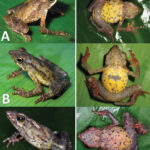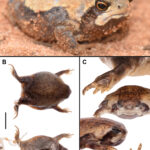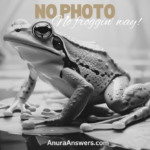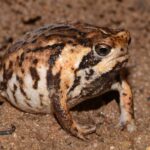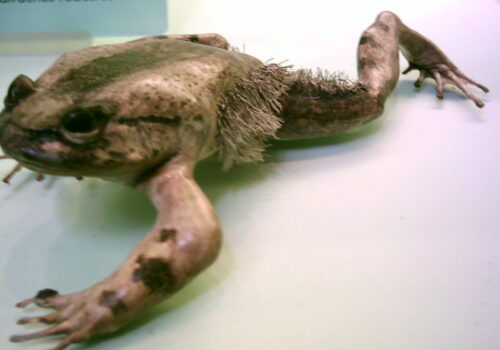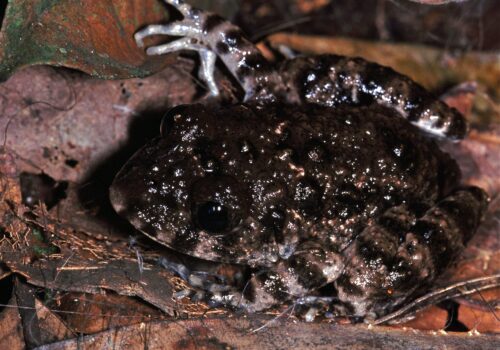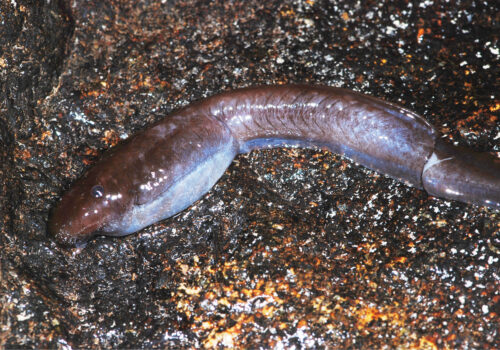- Introduction: Discovering Rheobates pseudopalmatus
- Taxonomy and Classification
- Natural Habitat: Life along Verdant Streams
- Physical Characteristics: Mastery in Subtlety
- Behavior and Life Cycle: Secretive Lives Revealed
- Ecological Role: Integral Threads in Forest Webs
- Threats and Conservation Status: Safeguarding a Species in Peril
- Cultural and Scientific Significance: Beyond Biological Boundaries
- Conclusion: Conserving Colombia's Hidden Amphibian Treasures
Introduction: Discovering Rheobates pseudopalmatus#
In the humid, moss-covered forests of Colombia’s Andean foothills, hidden beneath the leafy canopy and along banks of gently rushing streams, resides an inconspicuous dweller whose life often goes unnoticed. Rheobates pseudopalmatus, colloquially referred to as the False Palm Rocket Frog, is a remarkable species that illustrates nature’s splendid subtleties. Known for inhabiting pristine streams and damp forest undergrowth, this small but hardy amphibian encapsulates the dynamic balance that keeps forest ecosystems thriving.
Measuring barely larger than a coin, Rheobates pseudopalmatus may not dazzle with flamboyant color or size. Yet these tiny amphibians hold secrets worth exploring—secrets hinting at their importance in ecology and the urgent need for their conservation. Within its quiet existence lies a captivating story of adaptation, survival, and intricate ecological relationships. This article dives into the intriguing journey of a species that symbolizes the overlooked beauty and significance contained in the micro-worlds of our planet.
Taxonomy and Classification#
Belonging to the family Aromobatidae, Rheobates pseudopalmatus is situated neatly within a fascinating group of frogs collectively known as poison-arrow and rocket frogs, distinguished primarily by their subtle coloration, terrestrial habits, and in some cases, toxic yet chemically intriguing skin secretions. First described scientifically by Rivero and Serna in 2000, this frog represents just one thread amid a complex evolutionary tapestry.
The genus Rheobates, to which our species belongs, encapsulates a compelling lineage: specialized amphibians adapted skillfully to habitats closely tied to freshwater ecosystems. “Rheobates” itself derives from Greek origins—”rheo” meaning flowing, aptly reflecting their preference for environments near flowing waters such as mountain streams. Closely related species include members of the genus Allobates, as well as other aromobatid frogs sharing similar ecological niches and evolutionary traits.
Natural Habitat: Life along Verdant Streams#
Rheobates pseudopalmatus is endemic specifically to the Andean foothills of Colombia, embedded within lush tropical and subtropical forests whose verdure extends as far as eyes can explore. This vibrant landscape, adorned with epiphytic orchids and bromeliads and echoing with calls of countless avian species, provides the perfect sanctuary for this small frog.
Geographic Distribution and Preferred Environments#
Restricted largely within limited regions of western Colombia, R. pseudopalmatus thrives in habitats featuring dense leaf-litter, moss-carpeted forest floors, and clear-running mountain streams. Here, amidst profound humidity and shade under towering trees, the False Palm Rocket Frog lives discreetly yet crucially. This intimate association with clean, moving waters makes them indicators of pristine environmental conditions—a living testament of healthy ecosystems and well-preserved habitats.
The slender watercourses and miniature cascades not only serve as home but shape their everyday lives, affecting their behavior, breeding patterns, camouflage strategies, and micro-ecological relationships. The soundscapes associated with these habitats—the gentle whispers of flowing streams, occasional calls of exotic birds, and rustling of foliage—form the soundtrack to the frog’s hidden world.
Physical Characteristics: Mastery in Subtlety#
At first glance, Rheobates pseudopalmatus may seem an unassuming species. Adult individuals rarely exceed three centimeters in length, yet upon closer inspection, their physical charm emerges powerfully. A streamlined body marked by smooth skin, long muscular limbs evolved for quick jumping and agile navigation along slippery rocks, and delicate toes—these amphibians showcase nature’s ability to precisely tailor an organism for its environment.
Their coloration—usually a quiet spectrum of browns, olive-greens, and subtle tan gradients—expertly melds into surrounding rainforest substrates. Minute flecks, patterns, or occasionally vibrant orangish hues under the limbs can emerge upon closer observation, serving both to startle predators and attract mates during breeding season.
Adapted predominately for terrestrial life near water, these frogs possess special morphological traits: slightly expanded digit tips allowing stable navigation on wet surfaces and toes partly webbed as a nuanced adaptation to their semi-aquatic lifestyle. These poignant evolutionary details reveal an animal meticulously crafted by generations of natural selection, steadily refined for survival within their forest-stream habitat.
Behavior and Life Cycle: Secretive Lives Revealed#
Feeding and Predatory Strategies#
An insectivorous diet characterizes the daily existence of R. pseudopalmatus, emphasizing tiny arthropods such as ants, beetles, mites, and winged insects, abundant both terrestrially and in the vicinity of streams. With stealthy maneuvers and lightning-fast tongue-flicks, these frogs display expertise in capturing prey within their leafy microhabitats, reflected in finely-tuned sensory abilities.
Breeding and Parental Care#
The breeding patterns of Rheobates pseudopalmatus present a striking look into amphibian reproductive creativity. Like many related species, the males serenade potential mates with nuanced, high-pitched calls echoing softly above trickling rainforest streams, which contributes richly to the intricate sounds of the forest nights. Upon recognizing a suitable partner, males exhibit territorial behavior around optimal egg-laying sites near shallow waters.
Interestingly, eggs—secured carefully beneath moist leaf-litter or within sheltered locations adjacent to streams—are diligently guarded, typically guarded by the male against potential predators or fungal infection threats. Such diligent parental care illustrates the subtler side of frog behavior that novices and casual observers often overlook.
Tadpoles eventually emerge, uniquely adapted to succeed in gentle, flowing currents. Perfectly camouflaged and shaped for streaming waters, these aquatic larvae undergo profound physiological transformations, steadily advancing from watery dependence towards semi-terrestrial independence, meticulously choreographed by nature’s evolutionary hand.
Ecological Role: Integral Threads in Forest Webs#
While small, Rheobates pseudopalmatus bears tremendous ecological significance. Acting simultaneously as predator and prey, it intricately binds together the food webs permissible within their stream-side rainforest kingdoms. Tadpoles graze algae and organic debris within streams—an indispensable act in stabilizing water quality. Likewise, adult frogs help check terrestrial insect populations.
Besides their function within the trophic cascade, these frogs serve as environmental sentinels, capable of signaling subtle ecosystem disturbances before long-lasting ecological harm manifests.
Threats and Conservation Status: Safeguarding a Species in Peril#
The IUCN Red List categorizes Rheobates pseudopalmatus as “Vulnerable,” a designation reflecting severe habitat fragmentation and threats across Colombia’s Andean landscapes. Facing relentless challenges—from deforestation driven by agriculture and logging to water pollution and climate change-driven habitat shifts—this frog’s survival hangs atop fragile threads.
Conservationists express heightened concerns for this species due to its narrow habitat requirements and limited geographic distribution. Reduced genetic diversity and limited dispersal capabilities further compound their vulnerability levels, reinforcing an urgent need for robust ecological protection measures and comprehensive community conservation outreach.
Cultural and Scientific Significance: Beyond Biological Boundaries#
While not traditionally symbolized culturally to the extent other amphibians worldwide experience, the scientific fraternity greatly respects Rheobates pseudopalmatus as an invaluable bioindicator species. Scientists study them closely, hoping that pivotal research outcomes serve broader amphibian conservation perspectives.
Understanding amphibian-decline phenomena, chemical exposure consequences, and microhabitat-preservation essentials finds support via intense focus upon species like R. pseudopalmatus, which unequivocally underscores the species’ broader significance beyond mere niche occupancy.
Conclusion: Conserving Colombia’s Hidden Amphibian Treasures#
Ultimately, Rheobates pseudopalmatus encapsulates vital lessons concerning appreciating subtle biodiversity importance, safeguarding delicate ecological balances, and vigilantly confronting threats challenging global amphibian survival.
Inspiring action to conserve species like the False Palm Rocket Frog symbolizes broader biodiversity conservation focus, catalyzing preservation efforts at an ecosystem level marked by sustainable forest management, habitat corridor protection, and raised ecological awareness.
May this captivating frog remind us that even the smallest creatures reveal nature’s profound complexity. Join conservation organizations, educate fellow nature enthusiasts, and support initiatives actively defending species and spaces that shape Colombia’s—and indeed our planet’s—precious natural heritage.



